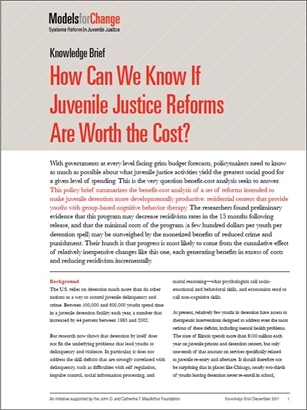Knowledge Brief: How Can We Know If Juvenile Justice Reforms Are Worth the Cost?
Published Dec 1, 2011, Models for Change Research Initiative
Download
(327 KB)

With governments at every level facing grim budget forecasts, policymakers need to knowas much as possible about what juvenile justice activities yield the greatest social good fora given level of spending. This is the very question benefit-cost analysis seeks to answer.This policy brief summarizes the benefit-cost analysis of a set of reforms intended tomake juvenile detention more developmentally productive: residential centers that provideyouths with group-based cognitive behavior therapy. The researchers found preliminaryevidence that this program may decrease recidivism rates in the 15 months followingrelease, and that the minimal costs of the program (a few hundred dollars per youth perdetention spell) may be outweighed by the monetized benefits of reduced crime andpunishment. Their hunch is that progress is most likely to come from the cumulative effectof relatively inexpensive changes like this one, each generating benefits in excess of costsand reducing recidivism incrementally.
This brief is one in a series describing new knowledge and innovations emerging from Models for Change, a multi-state juvenile justice initiative. Models for Change is accelerating movement toward a more effective, fair, and developmentally sound juvenile justice system by creating replicable models that protect community safety, use resources wisely, and improve outcomes for youths. The briefs are intended to inform professionals in juvenile justice and related fields, and to contribute to a new national wave of juvenile justice reform.